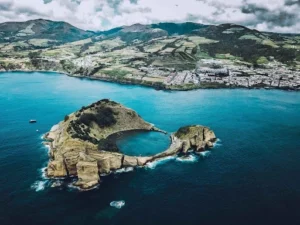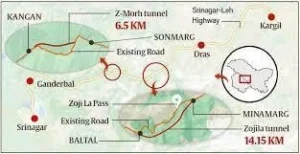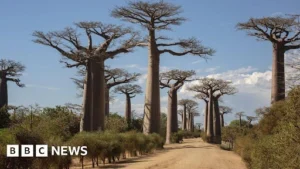UPSC GS 1
Azores Islands
- News: The regional assembly of Portugal’s Azores Islands approved the creation of the largest protected marine area in the North Atlantic to reach international conservation goals well ahead of time.
- Location: The Azores Archipelago comprises nine islands situated in the North Atlantic region.
- Origin and Geological Features:
-
- Volcanic Origin:
- The islands and their islets are primarily of volcanic origin, with some remaining inactive since their formation.
- The archipelago is part of the Autonomous Region of the Azores.
- Tectonic Setting:
- The islands originated from the Azores Plateau, located above the Azores Triple Junction, where three major tectonic plates—the Eurasian, North American, and African plates—intersect.
- The Mid-Atlantic Ridge serves as the principal geological structure between the African-Eurasian Plate and the North American Plate, traversing the Azores Plateau.
-

- Geographic Arrangement:
-
- Island Groups: The islands are oriented in a northwest-southeast direction and are categorized into three main groups: northwest, central, and eastern.
-
- Highest Point: Mount Pico, located on Pico Island, represents the highest elevation in the archipelago.
- Climate and Ecology:The Azores enjoy an oceanic subtropical climate, characterized by mild temperatures and significant precipitation.
- Fauna and Flora:
-
- The islands’ laurel forests are rich in biodiversity, hosting a variety of endemic plants and animals. Notably, at least two endemic bird species are found on the archipelago:
- The Azores bullfinch, which is confined to laurel forests.
- Monteiro’s storm petrel, another species native to the region.
-
Read also: Supreme Court Ruling on Section 6A of Citizenship Act | UPSC
Marine Heat Waves
- News: Researchers found that Marine Heat Waves deep in oceans may be “significantly under-reported” and caused by ocean currents.
- Marine Heat Waves (MHWs):
-
- A marine heat wave is classified as an extreme weather event characterized by a significant increase in sea surface temperatures.
- This phenomenon occurs when temperatures rise 3 to 4 degrees Celsius above the average for a specific area and persist for at least five consecutive days.
-
- Duration: Marine heat waves can last for varying periods, including weeks, months, or even years, as noted by the National Oceanic and Atmospheric Administration (NOAA) in the U.S. government.

- Impacts of Marine Heat Waves:
-
- Damage to Marine Habitats: MHWs can have devastating effects on marine ecosystems, including coral reefs and the displacement of various species.
- Increased Frequency: These events are occurring more often as a result of global warming, with significant instances reported along Australia’s East Coast, Tasmania, the northeast Pacific coast, and the North Atlantic.
- Impact on Storm Intensity: Higher ocean temperatures linked to MHWs can enhance the intensity of storms, such as hurricanes and tropical cyclones.
- Invasive Species Growth: MHWs create conditions conducive to the proliferation of invasive alien species, which can disrupt marine food webs.
-
- Effects on Weather Patterns:
-
- Storm Dynamics: Storms traversing over warm ocean waters tend to absorb more water vapor and heat, leading to increased intensity.
- Consequences for Landfall: This results in stronger winds, heavier rainfall, and heightened flooding upon reaching land, which escalates the potential for human devastation.
-
UPSC GS 2
Lady Justice Statue
- News: Recently, the Chief Justice of India unveiled the ‘new lady justice’ statue in the Supreme Court premises that replaced the ‘original lady justice’.
- Lady Justice Statue in India:
- British Influence in India:
-
- The image of Lady Justice was introduced to India through the British legal system during colonial rule.
- Courthouses across the country adopted this symbol, reflecting British legal traditions.
- At the Calcutta High Court, built in 1872, Lady Justice is represented in carvings—sometimes with a blindfold and sometimes without.
- The Bombay High Court also features a statue of Lady Justice, but it notably lacks the blindfold.
-

- Modern Representation in India:
-
- In 2024, the Supreme Court of India unveiled a new six-foot-tall statue of Lady Justice, breaking away from classical Western representations.
- The statue, crafted by artist Vinod Goswami, portrays Lady Justice in a saree, without a blindfold.
- Unlike traditional depictions, this version replaces the sword with a copy of the Constitution of India, while the scales remain in her hand.
-
- Symbolism of the New Depiction:
-
- The absence of the blindfold symbolizes that law is not blind but actively acknowledges and treats all people equally.
- This change reflects ongoing efforts to decolonize India’s legal system and aligns with modern legal reforms, promoting an inclusive and context-aware approach to justice.
-
- Origins of Lady Justice:
- Greek Mythology:
-
- The roots of Lady Justice trace back to ancient Greece, where Themis, one of the twelve Titans born to Gaea and Uranus, represented justice, wisdom, and good counsel.
- She is commonly depicted holding scales in one hand, representing fairness, and a sword in the other, signifying the enforcement of justice.
-
- Roman Influence:
-
- The Roman adaptation of the concept came through Justitia, introduced by Emperor Augustus as the goddess of justice.
- Similar to Themis, Justitia holds scales and a sword, though her image did not feature a blindfold.
-
- Origins of the Blindfold:
-
- The first known depiction of a blindfolded Lady Justice appears in a 1494 woodcut, titled “The Fool Blindfolding Justice,” part of the satirical work Ship of Fools by German lawyer Sebastian Brant.
- This early image, attributed to Albrecht Dürer, was intended as a critique of injustice, not a celebration of impartiality.
-
- Evolution of the Blindfold’s Meaning:
-
- By the 17th century, the blindfold evolved from its satirical origins to represent impartiality in justice, emphasizing that justice must be delivered without bias or favoritism.
-
Karmayogi Saptah’ – National Learning Week
- News: Prime Minister Shri Narendra Modi launched the ‘Karmayogi Saptah’ – National Learning Week at Dr Ambedkar International Centre in New Delhi recently.
- National Learning Week (NLW): NLW is the largest capacity-building event designed to enhance both individual and organizational skills among civil servants.
- Aim: The event seeks to promote a lifelong learning culture and align civil servants with national development objectives.
- Key Objective: NLW emphasizes the principle of “One Government” to foster better collaboration among Ministries, Departments, and Organizations.
- Targeted Learning:
-
- Civil servants, known as Karmayogis, are expected to engage in at least 4 hours of competency-based learning during the week.
- Learning is facilitated through role-specific modules available on the iGOT platform, along with webinars, public lectures, and policy masterclasses led by distinguished experts.
-
- Workshops and Seminars:
-
- Various Ministries, Departments, and Organizations will organize workshops and seminars to enhance specialized competencies.
- Sessions by eminent speakers will focus on improving citizen-centric service delivery and strengthening governance practices.
-
- Mission Karmayogi:
-
- Launch: Mission Karmayogi was introduced in September 2020.
- Purpose: It aims to develop a future-ready civil service that is rooted in Indian values but equipped with a global outlook.
- Progress: Significant advancements have been made since its launch, enhancing the efficiency and capabilities of civil servants
-
UPSC GS 3
Conference of the Parties (COP 16)
- News: The Sixteenth meeting of the Conference of the Parties (COP 16) will be held in Cali, Colombia from 21 October–1 November 2024.
- Convention on Biological Diversity (CBD):
- Membership: The CBD currently includes 196 contracting parties, making it the most comprehensive legally binding agreement for nature conservation and sustainable resource use.
- Adoption: The convention was opened for signing at the UN Conference on Environment and Development in Rio de Janeiro, 1992.
- Scope: It addresses biodiversity at all levels, including ecosystems, species, and genetic resources.
- Objectives of the CBD:
-
- Conservation of Biological Diversity: Focuses on preserving genetic diversity, species diversity, and habitat diversity.
- Sustainable Use of Biological Diversity: Promotes responsible utilization to meet present needs without compromising future biodiversity.
- Fair and Equitable Sharing of Benefits: Ensures that benefits derived from the use of genetic resources are fairly distributed among stakeholders.
-
- Governance and Structure:
-
- Conference of the Parties (COP): The COP serves as the convention’s highest governing body, comprising all ratifying governments (or Parties). It meets every two years to evaluate progress, establish priorities, and approve work plans.
-
- Secretariat: The CBD Secretariat is headquartered in Montreal, Canada.
- Protocols under the CBD:
-
- Cartagena Protocol (2000): This protocol, which became effective in 2003, regulates the transboundary movement of living modified organisms (LMOs) to ensure biosafety.
- Nagoya Protocol (2010): Provides a legally binding framework for access to genetic resources and ensures the fair distribution of benefits arising from their utilization.
-
Z-Morh Tunnel
- News: Seven people were killed in Jammu and Kashmir recently when suspected militants targeted the workers constructing the Z-Morh tunnel on the Srinagar-Sonamarg highway.
- Location:
-
- The Z-Morh tunnel is a 6.4-kilometer tunnel situated in central Kashmir’s Ganderbal district.
- It connects the Sonamarg health resort with Kangan town and is constructed near Gagangir village ahead of Sonamarg.
-

- Significance:
-
- This tunnel will provide all-weather connectivity to Sonamarg, a popular tourist destination along the Srinagar-Leh highway.
- It derives its name from the Z-shaped road stretch at the site of construction, located at an altitude of over 8,500 feet, which is prone to snow avalanches during winter.
- Consequently, the road to Sonamarg is often closed for much of the winter season.
-
- Strategic Importance of the Tunnel:
-
- Part of a Larger Project: The Z-Morh tunnel is integral to the Zojila tunnel project, aimed at ensuring year-round connectivity from Srinagar to Ladakh.
- Military Access: While providing all-weather connectivity to the Sonamarg health resort, it is essential for quick military access to the border areas of Ladakh. The construction of the Zojila tunnel, located at approximately 12,000 feet, connecting Sonamarg to Drass in Ladakh, is underway and expected to be completed by December 2026.
- Regional Connectivity: The Z-Morh tunnel will facilitate safe connectivity between Srinagar, Dras, Kargil, and Leh regions. The Indian defence forces are deployed in strategic areas, including Siachen Glacier and the Turtuk sub-sector, adjacent to Pakistan-Occupied Kashmir (PoK), as well as in Eastern Ladakh against Chinese forces.
- Logistical Benefits: All-weather road connectivity will reduce reliance on air maintenance for forward Army locations through Indian Air Force transport aircraft. The shift to road transport for troops and supplies will lead to lower operational costs and extend the lifespan of the aircraft.
-
Read also: Understand Global Hunger Index: Tackling Hunger in India | UPSC
African Baobab (Adansonia digitata)
- News: New research by South African ecologists has refuted the claim that the African Baobab (Adansonia digitata) tree is dying due to climate change.
- Growth and Structure:
-
- Baobabs are deciduous trees with varying sizes, ranging from 20 to 100 feet in height.
- These trees feature broad trunks and compact canopies, making them distinctive in appearance.
- They are renowned for their longevity, with some living for thousands of years.
- The oldest recorded baobab, known as the Panke baobab in Zimbabwe, reached an impressive age of 2,450 years.
-
- Distribution and Habitat:
-
- Adaptability: Baobabs are remarkably resilient, thriving in dry, open environments such as the savannas of southern Africa and western Madagascar.
- Solitary Growth: These trees often grow in isolation, enhancing their iconic presence within the landscape.
-

- Ecological Importance:
-
- Soil and Water Management:
- Baobabs contribute to soil moisture retention and nutrient recycling through their extensive root systems.
- They also help to reduce soil erosion, maintaining the health of the ecosystem.
- Water Storage:
- Their massive trunks act as reservoirs, absorbing and storing water during the rainy season to survive the dry months.
- Climate Resilience:
- Baobabs play a key role in mitigating the impacts of climate change, supporting biodiversity by providing both food and shelter to animals and humans.
-
- Nutritional and Medicinal Value:
-
- Fruit Production:
- Baobabs produce nutrient-rich fruits during the dry season, which can grow up to a foot in length.
- The fruit contains tartaric acid and is rich in Vitamin C, making it a critical food source for many species.
- Dietary Benefits:
- Baobab fruit is recognized for its high fibre content, acting as a natural prebiotic that promotes the growth of beneficial gut bacteria.
-

